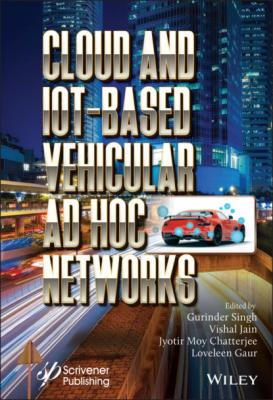Cloud and IoT-Based Vehicular Ad Hoc Networks. Группа авторов
Чтение книги онлайн.
Читать онлайн книгу Cloud and IoT-Based Vehicular Ad Hoc Networks - Группа авторов страница 3
 Power Aware Mechanism
15.4 Hybrid Mechanism
15.5 Simulation Results and Discussion
15.6 Performance Comparison
15.7 Conclusion
References
Power Aware Mechanism
15.4 Hybrid Mechanism
15.5 Simulation Results and Discussion
15.6 Performance Comparison
15.7 Conclusion
References
21 16 Simulating a Smart Car Routing Model (Implementing MFR Framework) in Smart Cities Introduction 16.2 Background 16.3 Literature Review 16.4 Methodology 16.5 Discussion and a Future Direction 16.6 Conclusions References
22 17 Potentials of Network-Based Unmanned Aerial Vehicles 17.1 Introduction 17.2 Applications of UAVs 17.3 Advantages of UAVs 17.4 UAV Communication System 17.5 Types of Communication 17.6 Wireless Sensor Network (WSN) System 17.7 The Swarm Approach 17.8 Market Potential of UAVs 17.9 Conclusion References
23 Index
List of Illustrations
1 Chapter 1Figure 1.1 Wireless communication IoT technologies [7].Figure 1.2 Force utilization in (dBm) for products low force Wi-Fi modules [5].Figure 1.3 Force utilization in (dBm) for products low force Wi-Fi modules [5].Figure 1.4 Illustrative case of Smart City assets that can profit by IoT when al...Figure 1.5 5G administrations that can be used for the IoT in smart cities [14].Figure 1.6 The pre-5G and the 5G IoT availability biological system [14].Figure 1.7 “Some specialized highlights of 5G administrations that can be used f...Figure 1.8 Elements of a 5G deployment [35].Figure 1.9 Carrier-neutral of “5G” deployment [35].Figure 1.10 Showing the architecture of the IoT with 5G [39].Figure 1.11 Illustration showing the AI and IoT relation to Form AIoT [20].Figure 1.12 The energy consumption ratio in cellular networks [10].Figure 1.13 Illustrative example ofthe proposed algorithm [41].Figure 1.14 The algorithm for the transmission [41].Figure 1.15 An illustrative example of the working of the transmission algorithm...
2 Chapter 2Figure 2.1 VANET Milieu.Figure 2.2 A framework of service discovery.Figure 2.3 Service discovery Architecture for 5G-VANET milieu.
3 Chapter 3Figure 3.1 Elements of ITS.Figure 3.2 Implanted vehicle sensors in ITS [5].Figure 3.3 ITS vehicular communications.Figure 3.4 Structure of three stage Internet of Things.Figure 3.5 Block diagram of ITS for human safety.Figure 3.6 Architecture of ITS for human safety.
4 Chapter 4Figure 4.1 Types of VANET architectures.Figure 4.2 Vehicle–Vehicle communication.Figure 4.3 Vehicle–Infrastructure communication.Figure 4.4 Vehicle–Broadband Cloud Communication.Figure 4.5 Long term evolution standardization timeline.Figure 4.6 Architectural view of video streaming over VANET in IOT domain.
5 Chapter 5Figure 5.1 Illustration of different modes of vehicular communication.Figure 5.2 Illustration of cellular IoT network architecture.Figure 5.3 Dedicated and shared CIoT networks with a common core network.Figure 5.4 Interleaver-based signaling between CIoT UE and CIoT or Cellular RAN.Figure 5.5 Extended signaling between CIoT UE, CIoT/Cellular RAN and CIoT servic...Figure 5.6 Interleaver-based signaling in V2I communication.Figure 5.7 gNB-initiated software upgrade signaling in V2I communication with op...
6 Chapter 6Figure 6.1 Frame work of the proposed system.Figure 6.2 Architecture of 6G-VANET Smart Transportation system.Figure 6.3 Proposed FMNMS1 Module.Figure 6.4 Proposed FMNMS2 Module.
7 Chapter 7Figure 7.1 IoT architecture.Figure 7.2 Cloud architecture.Figure 7.3 WSN architecture.Figure 7.4 IoT Cloud and WSN architecture.Figure 7.5 Health risk scale.Figure 7.6 System architecture.Figure 7.7 Sequence diagram.
8 Chapter 8Figure 8.1 VANET model.Figure 8.2 Vehicle collision scenario.Figure 8.3 Vehicle grouping.Figure 8.4 VANET security services.Figure 8.5 Vehicle group formation time.Figure 8.6 Vehicle authentication time.Figure 8.7 Vehicle collision rate.Figure 8.8 Data transmission rate.Figure 8.9 Privacy preservation level.
9 Chapter 9Figure 9.1 Traditional Network vs SDN.Figure 9.2 Evolution of services over network.Figure 9.3 DoS attack.Figure 9.4 Man-in-the-Middle attack.Figure 9.5 SDN architecture.Figure 9.6 Distributed SDN architecture.Figure 9.7 OpenFlow components.Figure 9.8 Connection establishment between OpenFlow switch and SDN controller.Figure 9.9 OpenFlow packet forwarding and processing.Figure 9.10 Comprehensive Security Architecture of SDN.Figure 9.11 Simple network topology.Figure 9.12 Pingall reachability test.Figure 9.13 Available bandwidth measurement.Figure 9.14 Packet loss and delay.Figure 9.15 Location based authentication model architecture.Figure 9.16 Location-based Registration Process.Figure 9.17 Location-based authentication and authorization process.Figure 9.18 IAM Policy Model Components.Figure 9.19 Extended TLS support.Figure 9.20 Defensive system flow.
10 Chapter 10Figure 10.1 Flowchart of EHO algorithm. Reference: link.springer.com [14].Figure 10.2 Pseudo code of clan updating operator [22].Figure 10.3 Pseudo code of separating operator [30].Figure 10.4 Pseudo code of EHO algorithm [12].
11 Chapter 11Figure 11.1 An example of the communication in VANET.Figure 11.2 Three layer communication in a VANET and clustering of sensors insid...Figure 11.3 Proposed registration process for a vehicle into an RSU.Figure 11.4 Flowchart to generate the cryptographically secured random sequences...
12 Chapter 13Figure 13.1 Route selection algorithm.Figure 13.2 Route selection and route estimation.Figure 13.3 Algorithm for congestion.Figure 13.4 Effective congestion algorithm.Figure 13.5 Simulation results.Figure 13.6 Improved simulation results.Figure 13.7 End to end delay.
13 Chapter 14Figure 14.1 CV2X functionality at the blind intersection of roads.Figure 14.2 5G CV2X communication for smart vehicle [7] [Courtesy: QUALCOMM].Figure 14.3 CV2X showing different 3GPP releases